Site founded September 1, 2000, passing a half million page views in July 2005
These home pages remain free of any charge. We need donations or subscriptions/gifts for students, military and family. Please pass on this website link to your family, relatives, friends and clients.
|

|
of History & Folklore
Subscribers Edition Stories & Photos
The most in-depth, comprehensive site about the Skagit.
Covers from British Columbia to Puget sound. Counties covered: Skagit, Whatcom, Island, San Juan. An evolving history dedicated to the principle of committing random acts of historical kindness
|
Noel V. Bourasaw, editor  810 Central Ave., Sedro-Woolley, Washington, 98284 810 Central Ave., Sedro-Woolley, Washington, 98284
Home of the Tarheel Stomp  Mortimer Cook slept here & named the town Bug Mortimer Cook slept here & named the town Bug
|

|
Capt. George Pickett, Lyman A. Cutlar
and the "Pig War" Crisis
By Mike Vouri, Historian, San Juan Island National Historical Park
and author of The Pig War: Standoff at Griffin Bay
When, on July 30, 1859, U.S. Army Captain George E. Pickett looked down the gun ports of two British warships from his camp on Griffin Bay, San Juan Island — he gulped and fired off a quick note to his superior at Fort Steilacoom:
From the threatening attitude of affairs at present, I deem it my duty to request the Massachusetts may be sent at once to this point. I do not know that any actual collision will take place, but it is not comfortable to be lying within range of a couple of war steamers. The Tribune, a 30-gun frigate, is lying broadside to our camp, and from present indications everything leads me to suppose that they will attempt to prevent my carrying out my instructions.
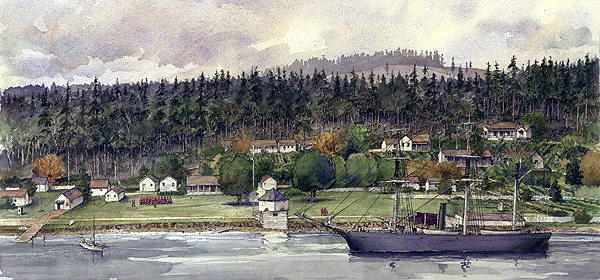
|
This fine painting of English camp on San Juan Island in the late 1860s is one of three by Richard Schlect on the official website of the San Juan Island National Historical Park. We urge you to see all three and to tour that site, which is filled with great information for those curious about the almost-war. The caption for the paintings reads: "Frederick, Maryland-based artist Richard Schlecht has created three exciting new paintings of the parade grounds at English and American camps and Belle Vue Sheep Farm. The artist based his work on historical photographs, drawings, paintings, maps and official documents from the park's collections as well as other archives in the United States, the United Kingdom and Canada. The paintings will be used to create wayside exhibits scheduled to be emplaced within the year."
|
Pickett's Company D, 9th Infantry, had arrived on San Juan Island from Fort Bellingham on July 27 to protect United States citizens from the British. The reason? An American settler had shot a pig belonging to the Hudson's Bay Company. Before it was all over, two nations would slide to the brink of war, only to be pulled back by the coolness and restraint of men on both sides — but especially two Royal Navy officers.
Obviously, more was involved than just a dead pig. For nearly 50 years, the two nations had been contending over possession of the Oregon Country — today's Washington, Oregon, Idaho, British Columbia and portions of Montana and Wyoming — which had been jointly occupied by the two nations since 1818. The Oregon Treaty, signed in 1846, should have resolved the problem when it divided the Oregon Country along the 49th parallel. The border would run from the Rocky Mountains through today's Blaine, Washington, down the middle of the Strait of Georgia, which divides Vancouver Island from the mainland, and out the Strait of Juan de Fuca to the Pacific Ocean.
However, the treaty makers in London failed to notice that the San Juan Islands bisect the Strait of Georgia into two channels, the Haro Strait running west of the islands, the Rosario Strait east. The Americans insisted on the former, the British the latter. In a hurry to sign the treaty, the nations agreed to hold the islands "in dispute" until a boundary agreeable to both nations could be divined. Unfortunately, no one thought to address the issue of jurisdiction over the islands — British or U.S., military or civil — which would be handled in a desultory and at times flammable manner.
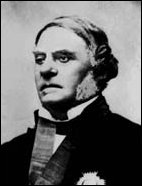 James Douglas, courtesy of the fine website about Lopez Island and their unique take on the San Juan Pig War.
James Douglas, courtesy of the fine website about Lopez Island and their unique take on the San Juan Pig War.
|
|
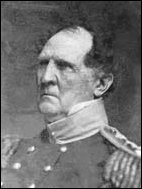 Gen. Winfield Scott, courtesy of the Lopez site.
Gen. Winfield Scott, courtesy of the Lopez site.
|
|
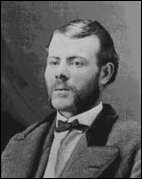 Charles Griffin, the shooter, courtesy of the Lopez Island site
Charles Griffin, the shooter, courtesy of the Lopez Island site
|
|
Hoping [to] solidify the British claim to the island the British-owned Hudson's Bay Company established a sheep farm on the island in 1853. Local U.S. officials responded by sending a procession of tax collectors and law enforcement officers to harass the operation, until called off by the president of the United States two years later. Then gold was discovered along the Fraser River in British Columbia, drawing thousands of prospectors to the area, the majority of them from the United States. Several drifted onto San Juan Island in the winter of 1859 and by June one of them shot a Company pig for rooting his garden. This generated a number of threats, imagined and otherwise, which resulted in Department of Oregon commander, Brigadier General William S. Harney on July 18, 1859, ordering Pickett's company to the island to prevent the British government from "assuming jurisdiction" over U.S. citizens.
While Harney's orders were en route to Fort Bellingham, British Governor James Douglas was retaining a stipendiary magistrate — or paid law enforcement officer — to not only treat with Lyman A. Cutlar, but to expel all American settlers from the island. On landing at San Juan on July 27, the magistrate, armed with only a revolving pistol, approached Pickett and ordered him leave the island or face arrest for "trespassing." With 60 soldiers behind him, not to mention two 12-pound mountain Howitzers and a six-pound Napoleon, Pickett refused, stating he was under orders to protect American citizens on the island — all 18 of them.
That's when Governor Douglas next dispatched the H.M.S. Tribune and the survey ship H.M.S. Plumper. The Tribune, Capt. Geoffrey Phipps Hornby commanding, was an auxiliary screw frigate with 31 guns and 330 men, while the HMS Plumper, a screw surveying ship, mounted 21 guns and carried a company of Royal Marines. They were joined two days later by the H.M.S. satellite, a 21-gun screw corvette. All three ships were part of the Royal Navy's Pacific Station force, in the process of moving from its headquarters in Valparaiso, Chile, to Esquimalt to contend with the Americans. [Ed. note: Lyman A. Cutlar's last name is often spelled Cutler, in many articles and even books and official documents.]
Hornby was ordered by British Governor James Douglas to prevent the Americans from erecting fortifications and bringing in reinforcements, "but not to risk a collision." Once on scene, Hornby decided he could not enforce these orders without more men, ships and guns. Only with overwhelming force, he believed, could he force Pickett off the island without firing a shot. But Douglas sent fresh orders the next day. Now Hornby was not to prevent additional Americans from landing, but to instead land an equal number of British Royal Marines on the island.
Meanwhile, following a brief visit by Pickett aboard the Tribune, Hornby viewed the Virginian as "more quiet than most of his countrymen, but he seems to have just the notion they all have of getting a name by some audacious act." Hornby also thought Pickett sounded more like "a Devonshire man than a Yankee."
As painfully polite as the encounter may have been, Pickett refused to leave. However, the frigate's gun drills — which included firing solid shot into a bluff about a half mile from Pickett's camp — unnerved the Virginian enough that he pulled up stakes and moved his force across the neck of the peninsula to a new encampment on South Beach.
In a letter to Pacific Station commander, Rear Admiral R. Lambert Baynes, Hornby puzzled over the move: The Americans "do not seem enclined (sic) to strengthen nor have any preparations for intrenching or other defence been made by them, though the camp has been shifted from its first site to one close to the sea on the other side of the island and equally exposed to the fire of Ships, as was their original one."
On August 3, Hornby — accompanied by the other two captains — met with Pickett at South Beach and told the Virginian that he had been ordered to land British troops on the island. Pickett stated that if the British landed he would "seize a small force; attack an equal one" and go down fighting if outnumbered. Hornby replied that he would land the minute he thought the "honor of the flag" or protection of British rights was at stake. At this, Pickett asked for 48 hours to consult with his superiors. Hornby replied, "Not one minute more."
However, being fully aware of the British government's policy of no confrontation — especially with the rising industrial might of the United States — Hornby determined not to follow Douglas' orders and land troops. He knew Pickett was not bluffing, so he sat tight and waited for his superior, Admiral Baynes.
Meanwhile, everyone on Griffin Bay — British, American, civilian and military — breathed a sigh of relief. Officers and men on both sides began to mingle on board the ships and in the camps, swapping British cigars for Oregon whiskey. Tourists came from Victoria to gawk at the Yankee soldiers and share with them the Victoria newspapers that screamed for Douglas' and Hornby's heads for "giving in."
When Baynes returned on August 5, he held an altogether different view than the newspapers. When told of the crisis, and the igniter of it — the dead Hudson's Bay Company pig — Baynes replied, "Tut, tut, no, no, the damned fools." And he supported Hornby's decision before the sputtering governor. As far as Baynes was concerned the British were not going to become enmeshed in another costly land war in North America — not on his watch.
On August 10, Lieutenant Colonel Silas Casey, the 9th Infantry Regiment's deputy commander, arrived from Olympia on August 10 with more troops and artillery, including all eight 32-pound naval guns from the war steamer U.S. S. Massachusetts. The guns were manhandled to the top of the rise overlooking the Bellevue Farm, where a redoubt was begun under the direction of Second Lieutenant Henry Martyn Robert, head of a detachment of army engineers.
Meanwhile, back in Washington, D.C., a horrified President James Buchanan, upon learning of the incident, immediately dispatched U.S. Army commander Lieutenant General Winfield Scott to mediate the affair. By the end of October, Scott had arrived and proposed as a solution, Douglas's second order to Hornby: a joint occupation of the island by British and American troops until the issue of ownership could be resolved. The governor had since changed his mind about a joint military occupation, but he did accede to a joint stand down, whereupon all reinforcements, British and U.S., were removed from the island. One company of U.S. soldiers would remain to protect the settlers from Indian raids.
On November 9, 1859, at the direction of Lieutenant General Winfield Scott, Pickett was ordered back to Fort Bellingham because Douglas the Southerner, ". . . of somewhat hasty temperament, punctilious and exacting." Scott also advised Harney to resign his command before he was fired.
Pickett moved back to Fort Bellingham in December, leaving his buildings and most of his stores behind. Then bad luck hit in the form of a squall that beached his chartered ship on the Griffin Bay shoreline. Managing to salvage about 60 percent of the stores — though his cannon and most of the new Harpers Ferry rifles were gone — Pickett and his men persevered at the considerably smaller Bellingham Bay fort throughout the winter, just a shade above starvation. None of the soldiers had been paid in nearly six months and they were making do with about 40 ancient smooth-bore muskets.
In December 1860 the two governments agreed to a joint military occupation of the island and by March 1860, the Royal Marines landed on the northern end of San Juan, where they established the camp they would occupy for the next 12 years. That spring Scott finally fired Harney after Harney had the temerity to remove Captain Lewis Cass Hunt (Scott's man) and replace him with Pickett, the very officer the British did not want to see!
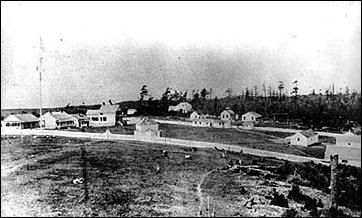 |
American Camp, courtesy of the park website
|
Pickett returned to San Juan Island anyway, where he remained until the outbreak of the Civil War. With the final departure of Company D, Fort Bellingham was closed for good. In 1867, Pickett's successors at Camp Pickett — being desperate for improved shelter — would venture over to the bay site and dismantle the remainder of the buildings.
During his second tour on San Juan Island, Pickett restored civil authority and used diplomacy to settle a potentially dangerous incident with the northern Indians. He also established warm relations with the company of British Royal Marine Light Infantry stationed on the northern end of the island; a relationship that would continue over 12 years. He also was prospering. The 1860 Census lists his personal assets at $25,000, most of it real estate, while the camp's assets were valued at $60,000, most in livestock and produce.
A year later, Fort Sumter was fired upon.
As with 313 other Southern officers, 184 of them West Pointers, serving in western commands, Pickett chose to serve his home state rather than the federal government. He tendered his resignation in June. But it wasn't until July 24, 1861 that he left his post at San Juan Island — three days after the first Battle of Bull Run.
Traveling incognito, Pickett took a steamer to Panama City, and crossed the isthmus by rail to Aspenwall (now Colon). He caught another steamer there for New York City and eventually found his way to Richmond, into the Confederate Army and the bloodiest war in U.S. history by September.
The British and American military forces, meanwhile, would peacefully remain on San Juan until the question of ownership was decided in binding arbitration by Kaiser Wilhelm I of Imperial Germany in November 1872.
About Michael Vouri
If you have ever had the pleasure, while on vacation, to visit San Juan Island in the vast archipelago of the Puget sound and join one of the tours led by Michael Vouri, then you know how entertaining he can be while also educating you. He has that rare ability to both inform people from young to old and inspire them to learn more about the subject he discusses. You may also remember him from when he did the George Pickett exhibit at the Whatcom Museum in 1994-95. He is dedicated and knows how to exercise scholarly discipline while writing in a manner that makes his book as much of a great summer read on vacation as it is a valuable resource for researchers and historians.
"We try to underplay the pig thing here," he explains, "which is impossible because visitors appreciate the irony. The important matter is that instead of fighting they kept the peace." I respect that notion a lot because and try to repeat it often in classes that I teach. It is the wars that define periods of time in the history books, but it is this instance of when an almost-war was avoided that fascinates people about the incidents that became known as the Pig War.
We asked Mike what makes his book different from earlier books about the island and the pig incident.
"The Pig War: Standoff at Griffin Bay is the only scholarly Pig War history in mass print at the moment, complete with index, end notes and bibliography. Moreover, I have put more than 12 years research and writing into the topic and am regularly consulted by scholars and news media worldwide, including the Skagit Valley Herald, which ran a feature about me last October. My latest book, published last fall, is entitled Outpost of Empire: The Royal Marines and the Joint Occupation of San Juan Island, also with endnotes and bibliography."
The Pig War: Standoff at Griffin Bay was published in 1999, 273 pages, $15.95. You can still find new copies at bookstores in Anacortes, Seattle and the islands, or it can be ordered at any bookstore.
More Journal stories on the Pig War and background reading
- Our introduction to a multi-part section about the almost-Pig War of 1859 on San Juan island between the United States and England, which never happened but is often celebrated and argued. Includes overview from a Pig War book, background and links to many other sources. Issue 26
- Mike Vouri presents an excerpt from his 1999 book, The Pig War: Standoff at Griffin Bay. Issue 26
- Ray Jordan researched the estate of Lyman Cutlar, the central figure of the Pig War, including his residence at Samish after the San Juans and found many documents to help tell Cutlar's story. Issue 26
- Ray Jordan writes about the famous shotgun that Lyman Cutlar used to kill the omnivorous pig. Issue 26
Story posted on Feb. 26, 2005
Did you enjoy this story? Please consider subscribing to the optional Subscribers Edition. That is how we fund this grand project.
Please report any broken links or files that do not open and we will send you the correct link. Thank you.
|
Return to our home page anytime
You can read about our prime sponsors:
 Allelujah Business Systems/Copies/Mailbox, 133-B State St., Sedro-Woolley, 360 855-1157 Allelujah Business Systems/Copies/Mailbox, 133-B State St., Sedro-Woolley, 360 855-1157
Preserve your family keepsakes . . . allcopiersystems web page
 Schooner Tavern/Cocktails at 621 Metcalf street in downtown Sedro-Woolley, across from Hammer Square: www.schoonerwoolley.com web page . . . History of bar and building Schooner Tavern/Cocktails at 621 Metcalf street in downtown Sedro-Woolley, across from Hammer Square: www.schoonerwoolley.com web page . . . History of bar and building
 Oliver Hammer Clothes Shop at 817 Metcalf street in downtown Sedro-Woolley, 82 years. Oliver Hammer Clothes Shop at 817 Metcalf street in downtown Sedro-Woolley, 82 years.
 Joy's Sedro-Woolley Bakery-Cafe at 823 Metcalf street in downtown Sedro-Woolley, 82 years. Joy's Sedro-Woolley Bakery-Cafe at 823 Metcalf street in downtown Sedro-Woolley, 82 years.
 Heirloom Gardens Natural Foods at 805B Metcalf street, the original home of Oliver Hammer. Heirloom Gardens Natural Foods at 805B Metcalf street, the original home of Oliver Hammer.
 Bus Jungquist Furniture at 829 Metcalf street in downtown Sedro-Woolley, 36 years. Bus Jungquist Furniture at 829 Metcalf street in downtown Sedro-Woolley, 36 years.
 Check out Sedro-Woolley First for links to all stories and reasons to shop here first Check out Sedro-Woolley First for links to all stories and reasons to shop here first
or make this your destination on your visit or vacation.
Peace and quiet at the Alpine RV Park, just north of Marblemount on Hwy 20
Park your RV or pitch a tent by the Skagit river, just a short driver from Winthrop or Sedro-Woolley.
Would you like to buy a country church, pews, belfry, bell, pastor's quarters and all? Email us for details.
|
|
|
Did you find what you were looking for? If not, please email us and tell us what you seek and we will put it on our list to research. The more details, the better.
|
Please sign our guestbook so our readers will know where you found out about us, or share something you know about the Skagit River or your memories or those of your family. Share your reactions or suggestions or comment on our Journal. Thank you for taking time out of your busy day to visit our site.
|
Sign Our Guestbook

View Our Guestbook
|
Remember, we welcome correction and criticism. Please click on the email slot at the right to report any problems with these pages or to suggest ideas for future stories. This is a completely free site. We fund it by providing an online magazine for paid subscribers. If you are not already a subscriber and you would like to help support our considerable research costs, you can subscribe for just $20.00 per year. As a paid subscriber, you will receive eight yearly issues plus many rare treats between times, including scans of photos and documents that illustrate local history, before they are shared with anyone else. You can go here for Subscription details and you can read the preview edition to see examples of our in-depth research. You may also order gift subscriptions for friends, family or clients who are interested in local history or students or military people who are away from home. Or you can email us for more details. Do you have scanned photos to share? Or you can mail us copies. See addresses to right.
|
Email us at: journal@stumpranchonline.com

Mail copies/documents to street address: Skagit River Journal, 810 Central Ave., Sedro-Woolley, WA, 98284.
|

 810 Central Ave., Sedro-Woolley, Washington, 98284
810 Central Ave., Sedro-Woolley, Washington, 98284



